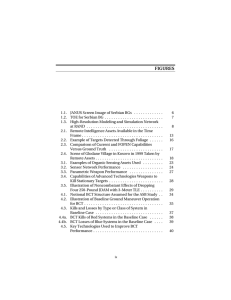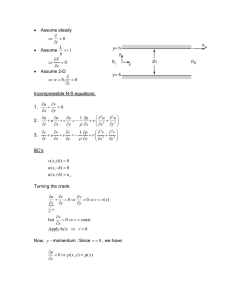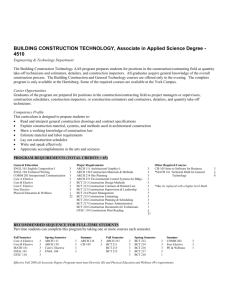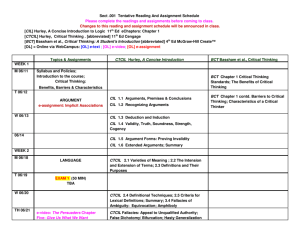AR
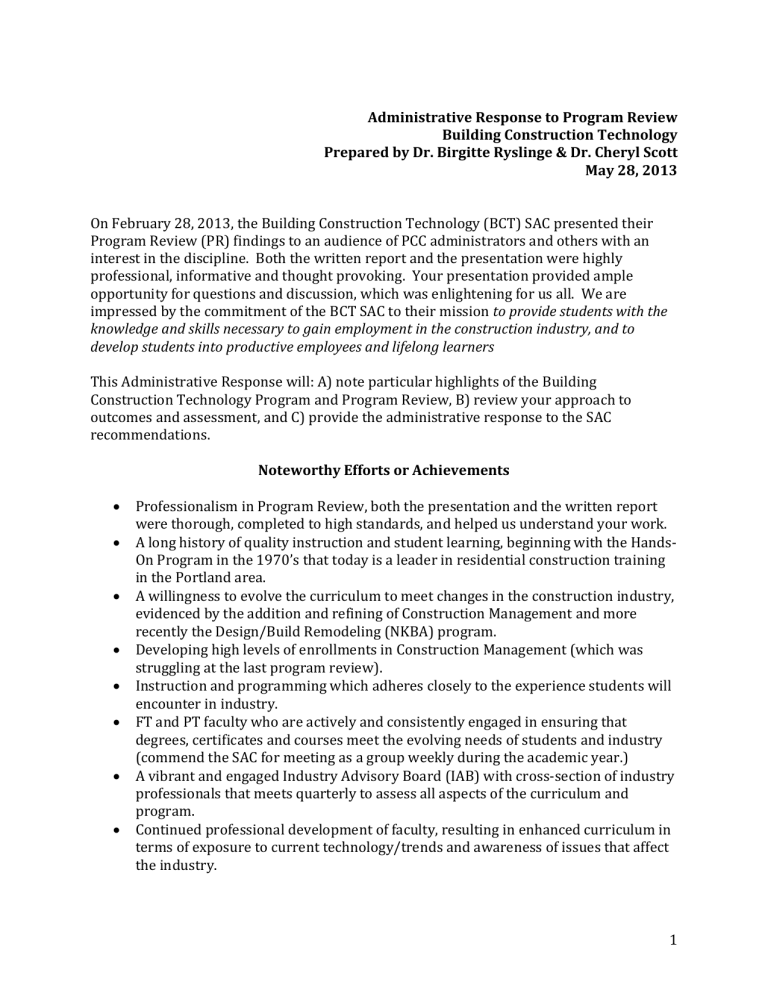
Administrative Response to Program Review
Building Construction Technology
Prepared by Dr. Birgitte Ryslinge & Dr. Cheryl Scott
May 28, 2013
On February 28, 2013, the Building Construction Technology (BCT) SAC presented their
Program Review (PR) findings to an audience of PCC administrators and others with an interest in the discipline. Both the written report and the presentation were highly professional, informative and thought provoking. Your presentation provided ample opportunity for questions and discussion, which was enlightening for us all. We are impressed by the commitment of the BCT SAC to their mission to provide students with the knowledge and skills necessary to gain employment in the construction industry, and to develop students into productive employees and lifelong learners
This Administrative Response will: A) note particular highlights of the Building
Construction Technology Program and Program Review, B) review your approach to outcomes and assessment, and C) provide the administrative response to the SAC recommendations.
Noteworthy Efforts or Achievements
Professionalism in Program Review, both the presentation and the written report were thorough, completed to high standards, and helped us understand your work.
A long history of quality instruction and student learning, beginning with the Hands-
On Program in the 1970’s that today is a leader in residential construction training in the Portland area.
A willingness to evolve the curriculum to meet changes in the construction industry, evidenced by the addition and refining of Construction Management and more recently the Design/Build Remodeling (NKBA) program.
Developing high levels of enrollments in Construction Management (which was struggling at the last program review).
Instruction and programming which adheres closely to the experience students will encounter in industry.
FT and PT faculty who are actively and consistently engaged in ensuring that degrees, certificates and courses meet the evolving needs of students and industry
(commend the SAC for meeting as a group weekly during the academic year.)
A vibrant and engaged Industry Advisory Board (IAB) with cross-section of industry professionals that meets quarterly to assess all aspects of the curriculum and program.
Continued professional development of faculty, resulting in enhanced curriculum in terms of exposure to current technology/trends and awareness of issues that affect the industry.
1
Engagement of the BCT SAC at a campus and college level. The impact of the BCT
SAC is wide-ranging, from building kid sized tables for the RC Learning Garden, to involvement in college wide scholarship fundraising, the BCT SAC steps up and contributes significantly to the vibrancy of Rock Creek, and to PCC’s mission as a whole.
Student projects which benefit the campus and community.
Effective advocacy by BCT to have PCC students intern with our Bond program.
In summary, the BCT program has accomplished a great deal for which to be commended.
Throughout its long history, the BCT faculty and staff have continued to provide a high quality experience for students, and ensured that PCC BCT graduates are in high demand for employment.
Outcomes and Assessment
Assessment was identified as an area of focus for PCC during our very recent accreditation visit, and the April 2010 Interim Accreditation Report noted that: PCC must document
“progress in demonstrating, through regular and systematic assessment, that students who complete their programs have achieved the intended learning outcomes of degrees and certificates. Further, the college must begin to demonstrate, in a regular and systematic fashion, how the assessment of student learning leads to the improvement of teaching and learning.”
Given the importance of this work to the college, we would like to acknowledge SACs as they undertake the work of outcomes and assessments. The BCT program review reflects authentic engagement with the work of identifying outcomes and using assessment to ensure the program adequately prepares students for the professional expectations that await them. The BCT SAC has effectively identified course and program level outcomes, and designed student assessments that ensure that students are learning what is promised.
Additionally, the BCT SAC has clearly identified where and how offerings address the college core outcomes.
College Core Outcomes are thoroughly addressed, and documented as such with an up-todate Core outcome mapping. http://www.pcc.edu/resources/academic/core-outcomes/bct.html
Very well developed Program Outcomes for all degrees and certificates are provided in
Appendix A and B, for:
Associate of Applied Science Degree o Building Construction Technology o Building Construction Technology: Construction Management Option o Building Construction Technology: Design/Build Remodeling Option
Less than One-Year Certificate o Building Construction Technology
2
Outcomes are also developed and documented for the Course Level. Examples of the course outcomes being addressed in the CCOGs is found in Appendix A & B.
Administrative Response to BCT Recommendations
We concur with many of the BCT recommendations, and in fact PCC administration has already acted upon some. In those areas of agreement, we note that some are more constrained by funding availability, and that requests dependent on funding are typically subject to a variety of campus and district based allocation processes. Overall, we have the usual challenge of supporting worthwhile and effective disciplines in a time of growing competition for limited resources. The question becomes, what can we do with the resources we have now? In that spirit, here are administrative responses to the SAC recommendations contained within the BCT Program Review
1.
COMMITTED BOND PROJECTS: Since the BCT worksite will be dramatically impacted by bond work, we feel that implementation and funding of this work as agreed on in the design planning phase is critical. This includes: a.
Adequate funding for replacement and relocation of the remodeling houses and weatherization house. b.
Installation of the new bathroom facilities. c.
Construction of new access to the BCT worksite. d.
Construction of the East/West concrete wall separating BCT from the proposed greenspace. e.
Construction of the North/South concrete wall separating BCT from the proposed grounds Landscape Maintenance area. f.
Lighting and adequate power at the revised worksite. g.
Any other requirements agreed upon in the bond meetings and minutes.
We appreciate the detailed request for the status of the RC bond projects. As you know, there are many unknowns at this time. Until more information is available about the potential second entrance to the campus, the direct effect a second road may have on the BCT program will not be known.
One item that was not listed above is regarding the dust collection system in building 2. We have moved forward with the repair of the system at about twice the original cost.
That said, we appreciate the spirit and scope of the questions. We do not want to take away from the programming and do not intend that the bond projects will have a negative impact on BCT programs. a.
While we aren’t able to specify the level of funding, the plan is to ensure that there is not a negative impact on the BCT programs. b.
This is one of the requests for bond funding. All requests are subject to the needs, priorities and the availability of funding.
3
c.
This is one of the requests for bond funding. All requests are subject to the needs, priorities and the availability of funding. d.
This is one of the requests for bond funding. All requests are subject to the needs, priorities and the availability of funding. e.
This is one of the requests for bond funding. All requests are subject to the needs, priorities and the availability of funding. f.
Yes, it is always the intent to have adequate lighting and power for PCC programs. g.
This is a very broad statement. Any decisions made regarding the bond will be implemented through the normal process.
2.
COMPUTER LAB SPACE: The college needs to replace the BCT computer lab that was taken away from us since the last program review. The current temporary facility has served its purpose, but must be replaced. BCT is more than willing to share open timeslots that are not utilized by BCT courses.
We concur that computer lab space needs to be considered for the BCT program. Please engage in classroom allocation discussions that will occur at the RC campus as the build out of the Bond projects progresses. Contact your Division Dean for more information.
3.
BCT DEDICATED CLASSROOM. BCT is the ONLY CTE program at Rock Creek without a dedicated classroom within which materials could be stored, and an identity for the program developed. The shop currently serves this function, but space there is limited, and this has no impact on Construction Management students who do not take hands-on classes.
We concur that classroom space needs to be considered for the BCT program. Please engage in classroom allocation discussions that will occur at the RC campus as the build out of the
Bond projects progresses. Contact your Division Dean for more information.
4.
SOCIAL MEDIA ASSISTANCE: Engaged support from the College, including setting up
‘shells’ for each program in Facebook and Linked-In, would be of great help to the
CTE programs in general.
We concur that “shells” for each program in Facebook and Linked-In would be helpful for programs at the college. Please work with TSS to request this support. You might also consider contacting faculty in the CAS program at RC for assistance with the development of a shell. Perhaps a student could be assigned a special project to assist with this project.
5.
MARKETING ASSISTANCE: BCT faculty would appreciate assistance from the
College in more actively marketing the BCT program, and other CTE programs that teach a trade, to minorities and women.
4
Program outreach, marketing and public relations are most certainly an area where CTE programs need support and assistance. Rock Creek has made a permanent investment in staff to focus on public relations/community outreach (Janis Nichols) as well as student/high school outreach (David Martinez).
In addition, the college recently launched a “DIY” marketing model. Each division had an
Administrative Assistant attend the training and can provide assistance for marketing materials. Please work with your division dean to determine who attended from your division.
Please ensure that you work with all of these resources to your outreach efforts and to
possibly identify additional leveraged opportunities.
6.
ONLINE EVALUATION IMPROVEMENT: BCT Faculty encourage the College to develop a more robust enforcement protocol for the online course evaluation system so that we once again receive universal, meaningful feedback.
The DOIs agree that the responses on the online evaluation tool need to continue to be improved. A committee of faculty has been formed to continue to improve both the tool and the response rate. The response rate has increased each term and the DOIs will continue to work on finding ways to ensure meaningful and robust feedback.
7.
ALUMNI TRACKING ASSISTANCE: Begin with adopting the pilot described above that was developed by Todd Sanders and Paul Wild.
We spoke with Russell Banks, PCC Director of Communications, in regards to this recommendation. Beginning in July 2013, the Advancement office will be piloting alumni outreach with targeted alumni segments. It appears BCT might be a good candidate. We encourage BCT to connect with Russell to volunteer for this effort. Please include your
Division Dean in communications with Russell to assist in facilitating these efforts. Russell has not seen the results of the original BCT alumni pilot and requests that a copy be sent to him.
8.
SACC CHAIR: Evaluate and address the responsibilities associated with the uncompensated SACC Chair position. Recognize that the work hours required to develop and maintain Assessments, Program Reviews, Technical Skills Assessments,
Program Improvements, Curriculum Improvements, etc. in CTE programs is significant, necessary, and entirely uncompensated.
Increased demands for accountability and declining state and federal resources for the college are a reality. The increase in the work that diverts faculty from scholarship and instruction, but which focuses on assessment of student learning is work that should be done by faculty and should be integral to evaluating and improving teaching and learning in your discipline.
We know that the SAC understands that this work is integral to addressing compliance issues
and accreditation and appreciate the effort the BCT SAC has made in this direction.
5
Closing
We want to again thank the Building Construction Technology SAC for sharing the results of your program review with us. We very much enjoyed learning about new developments for the BCT discipline, your successes and your plans for the future. We look forward to supporting your on-going work on continuous program improvement.
Administrative Response respectfully submitted by Dr. Birgitte Ryslinge and Dr. Cheryl
Scott on behalf of:
Cheryl Scott, Interim Dean of Instruction, Rock Creek Campus
Craig Kolins, Dean of Instruction & Student Development Southeast Center/Extended
Learning Campus
Jeff Triplett, Dean of Instruction, Sylvania Campus
Kendra Cawley, Dean of Academic Affairs
Kurt Simonds, Deans of Instruction, Cascade Campus
6

